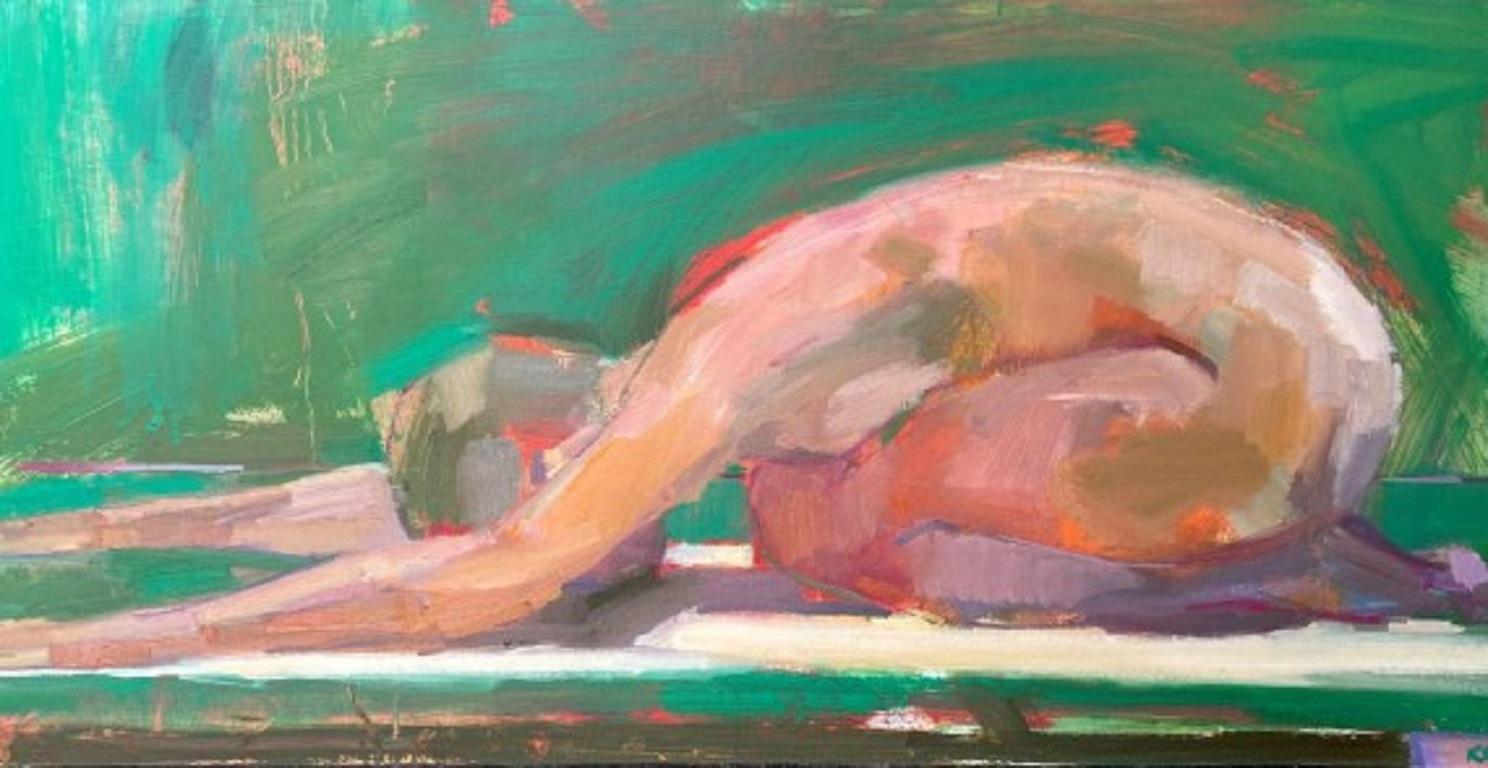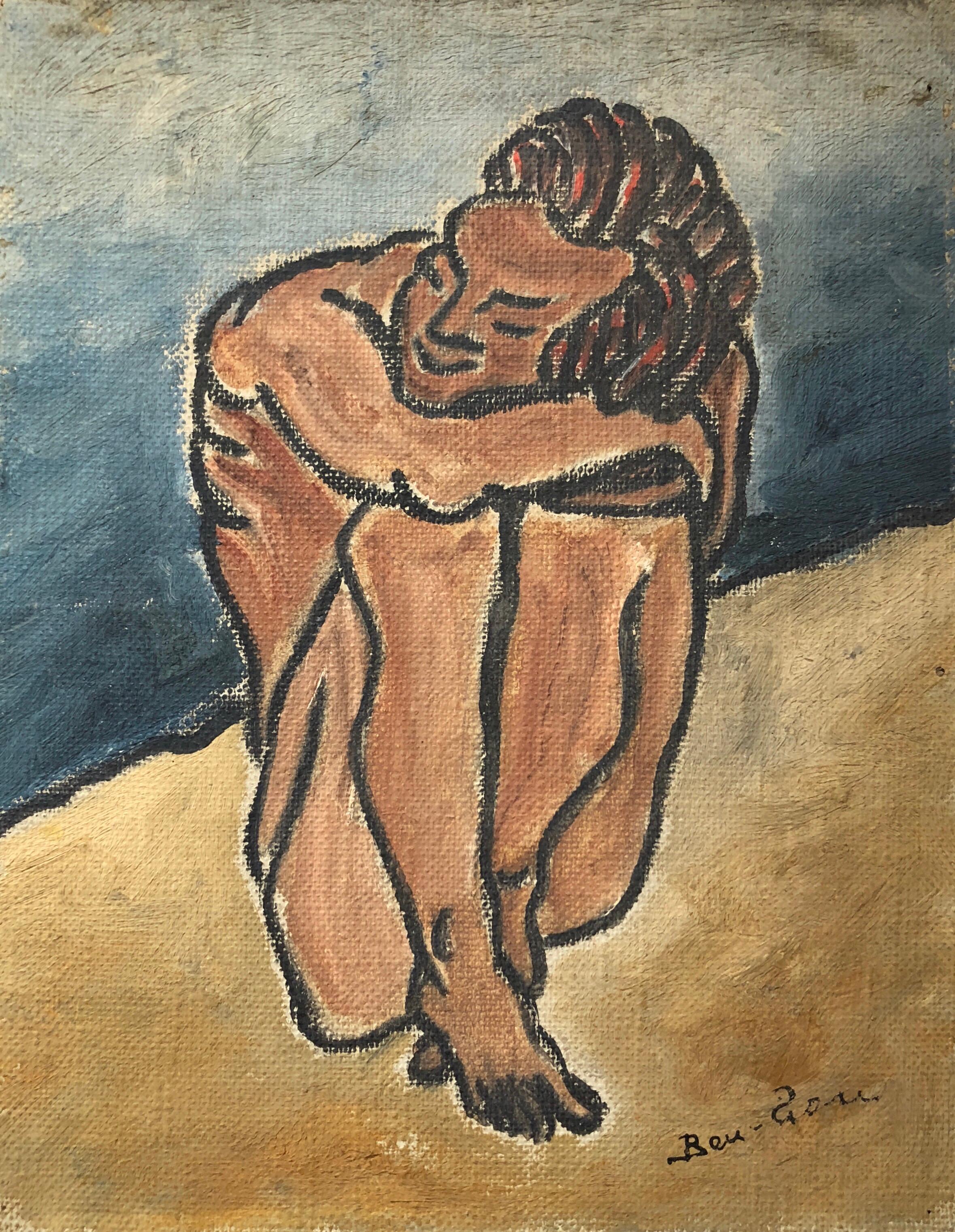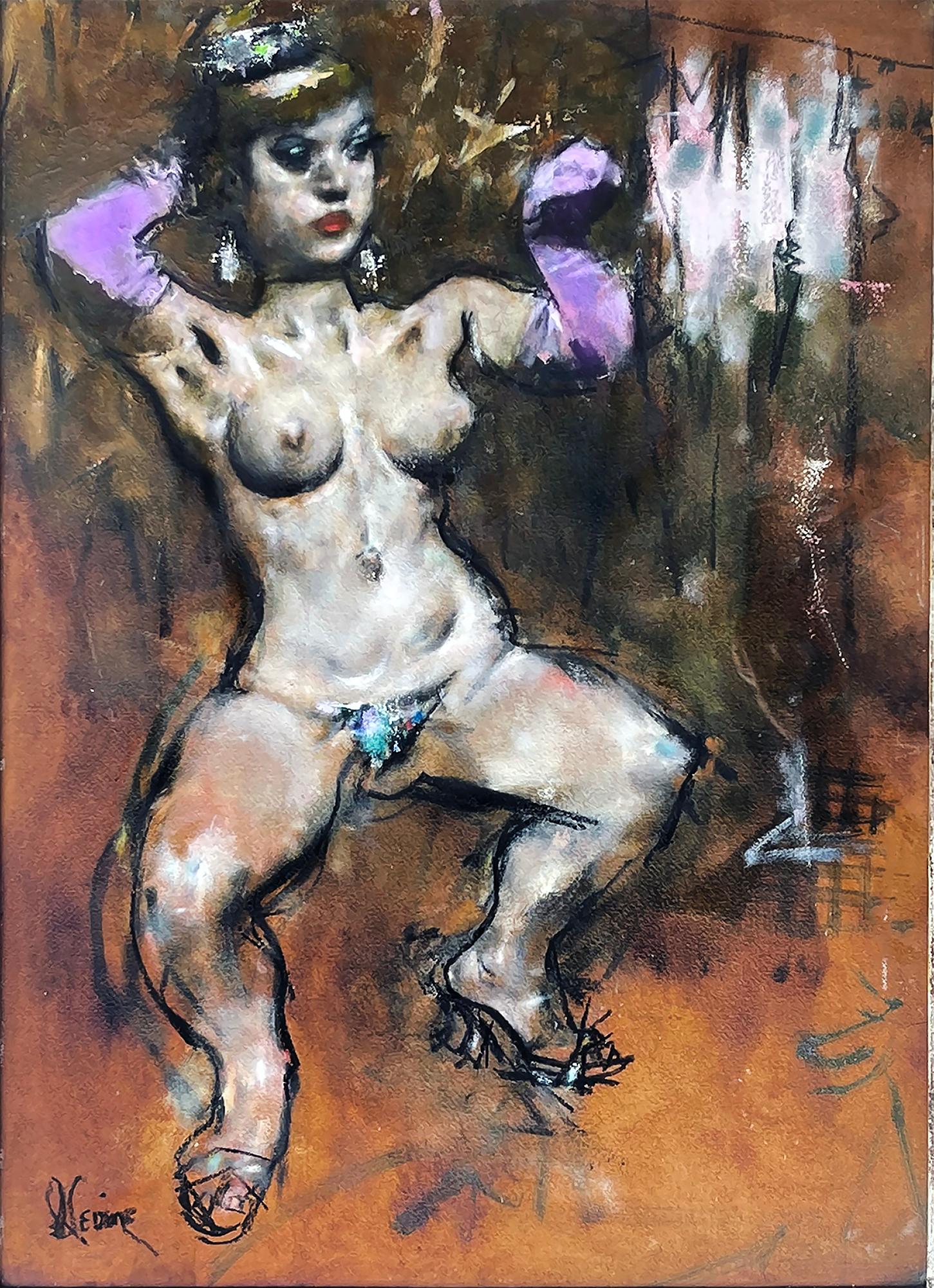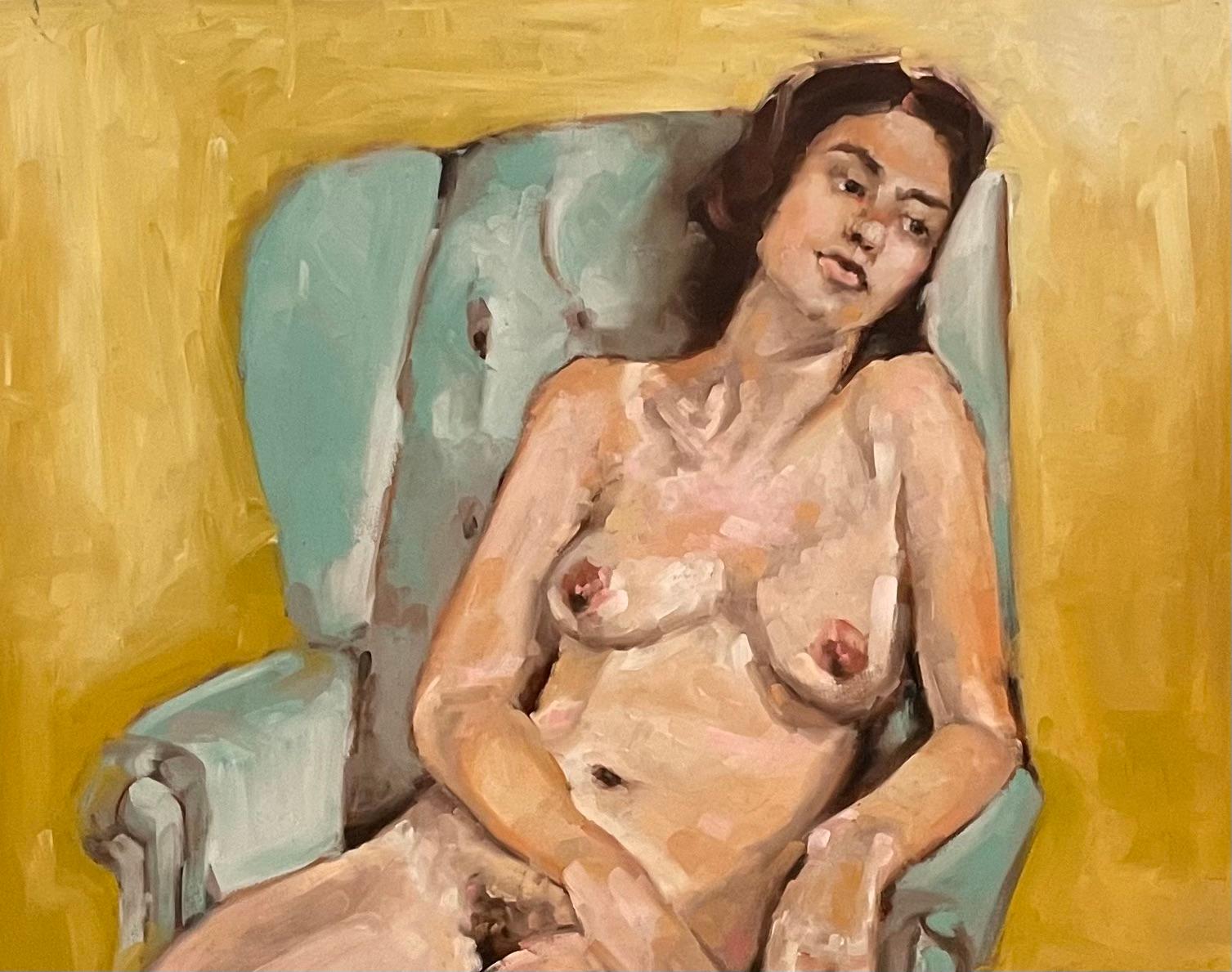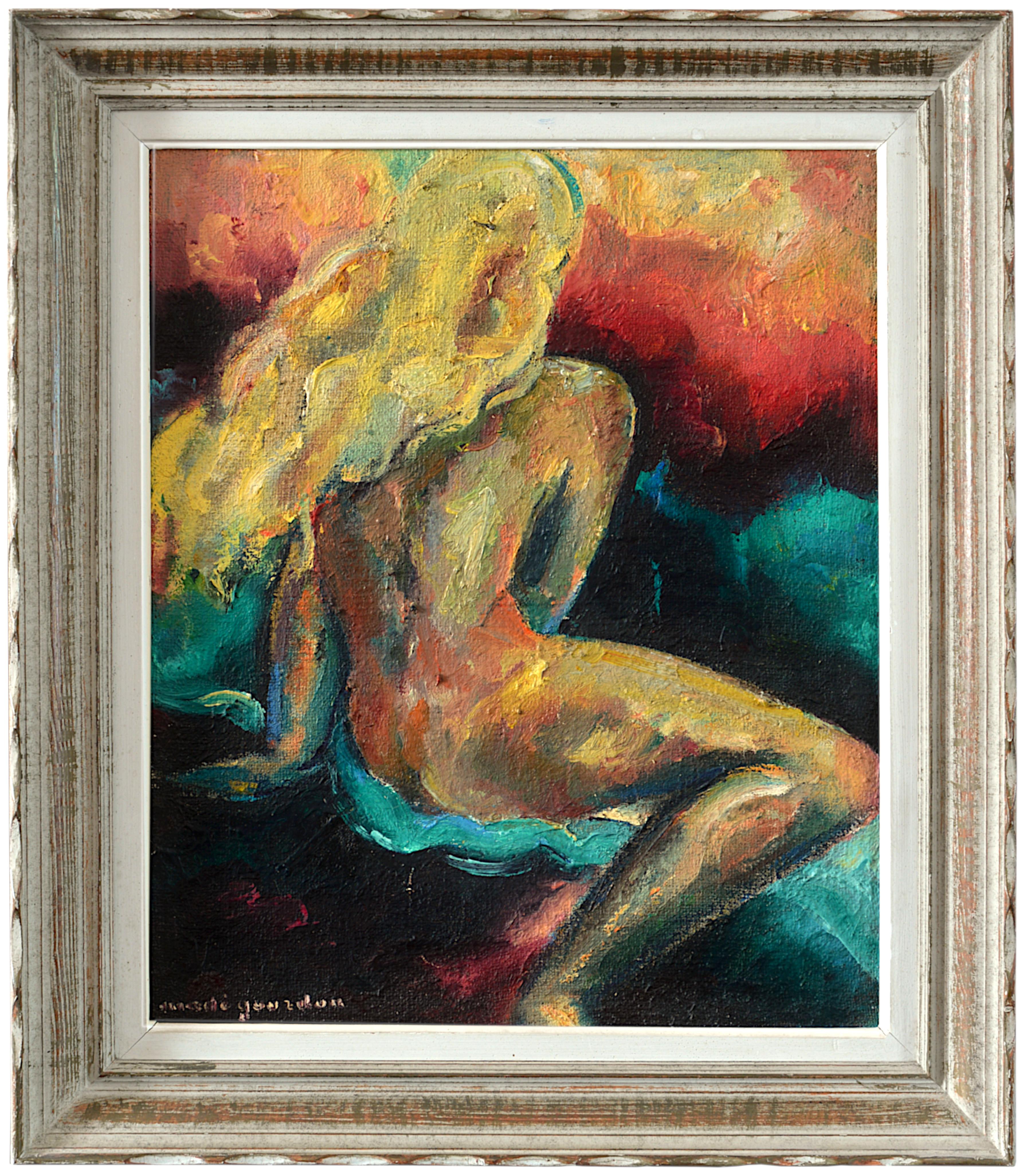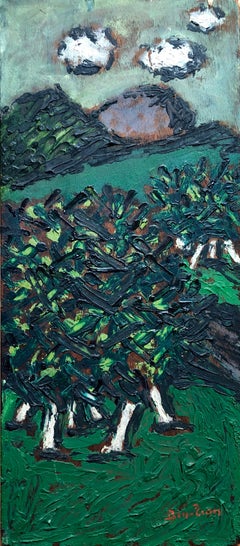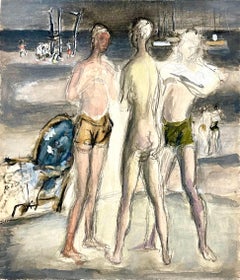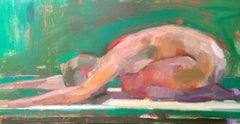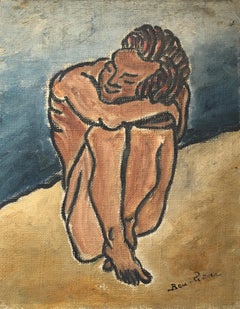
American Modernist Oil Painting Nude Male on Beach WPA Artist Group of 10
View Similar Items
Want more images or videos?
Request additional images or videos from the seller
1 of 6
Ben-Zion WeinmanAmerican Modernist Oil Painting Nude Male on Beach WPA Artist Group of 10
About the Item
- Creator:Ben-Zion Weinman (1897 - 1987, American)
- Dimensions:Height: 9 in (22.86 cm)Width: 7 in (17.78 cm)
- Medium:
- Movement & Style:
- Period:
- Condition:minor wear, mostly around edges where it was matted, see photos.
- Gallery Location:Surfside, FL
- Reference Number:1stDibs: LU3823194621
About the Seller
4.9
Platinum Seller
These expertly vetted sellers are 1stDibs' most experienced sellers and are rated highest by our customers.
Established in 1995
1stDibs seller since 2014
1,543 sales on 1stDibs
Typical response time: 1 hour
More From This SellerView All
- American Modernist Oil Painting Nude Male on Beach WPA Artist Group of 10By Ben-Zion WeinmanLocated in Surfside, FLBorn in 1897, Ben-Zion Weinman celebrated his European Jewish heritage in his visual works as a sculptor, painter, and printmaker. Influenced by Spinoza, Knut Hamsun, and Wladyslaw Reymont, as well as Hebrew literature, Ben-Zion wrote poetry and essays that, like his visual work, attempt to reveal the deep “connection between man and the divine, and between man and earth.” An emigrant from the Ukraine, he came to the US in 1920. He wrote fairy tales and poems in Hebrew under the name Benzion Weinman, but when he began painting he dropped his last name and hyphenated his first, saying an artist needed only one name. Ben-Zion was a founding member of “The Ten: An Independent Group” The Ten” a 1930’s avant-garde group, Painted on anything handy. Ben-Zion often used cabinet...Category
Mid-20th Century Expressionist Figurative Paintings
MaterialsOil, Board
- American Modernist Oil Painting Gestural Landscape WPA Artist Group of 10By Ben-Zion WeinmanLocated in Surfside, FLBorn in 1897, Ben-Zion Weinman celebrated his European Jewish heritage in his visual works as a sculptor, painter, and printmaker. Influenced by Spinoza, Knut Hamsun, and Wladyslaw Reymont, as well as Hebrew literature, Ben-Zion wrote poetry and essays that, like his visual work, attempt to reveal the deep “connection between man and the divine, and between man and earth.” An emigrant from the Ukraine, he came to the US in 1920. He wrote fairy tales and poems in Hebrew under the name Benzion Weinman, but when he began painting he dropped his last name and hyphenated his first, saying an artist needed only one name. Ben-Zion was a founding member of “The Ten: An Independent Group” The Ten” a 1930’s avant-garde group, Painted on anything handy. Ben-Zion often used cabinet doors...Category
Mid-20th Century Expressionist Figurative Paintings
MaterialsOil, Wood Panel
- Simka Simkhovitch WPA W/C Painting Gouache American Modernist Beach Scene NudeBy Simka SimkhovitchLocated in Surfside, FLSimka Simkhovitch (Russian/American 1893 - 1949) This came with a small grouping from the artist's family, some were hand signed some were not. These were studies for larger paintings. This is a watercolor and gouache beach scene three young men bathing...Category
1930s American Modern Nude Paintings
MaterialsWatercolor, Gouache, Board
- Simka Simkhovitch WPA Artist Painting Gouache American Modernist Beach SceneBy Simka SimkhovitchLocated in Surfside, FLSimka Simkhovitch (Russian/American 1893 - 1949) This came with a small grouping from the artist's family, some were hand signed some were not. These were studies for larger paintings. Simka Simkhovitch (Симха Файбусович Симхович) (aka Simka Faibusovich Simkhovich) (Novozybkov, Russia May 21, 1885 O.S./June 2, 1885 N.S.—Greenwich, Connecticut February 25, 1949) was a Ukrainian-Russian Jewish artist and immigrant to the United States. He painted theater scenery in his early career and then had several showings in galleries in New York City. Winning Works Progress Administration (WPA) commissions in the 1930s, he completed murals for the post offices in Jackson, Mississippi and Beaufort, North Carolina. His works are in the permanent collections of the Dallas Museum of Art, the National Museum of American Art and the Whitney Museum of American Art. Born outside Kyiv (Petrograd Ukraine) into a Jewish family who owned a small department store. During a severe case of measles when he was seven, Simcha Simchovitch sketched the views outside his window and decided to become an artist, over his father's objections. Beginning in 1905, he studied at the Grekov Odessa Art School and upon completion of his studies in 1911 received a recommendation to be admitted to the Imperial Academy of Arts. Though he enrolled to begin classes in architecture, painting, and sculpture at the Imperial Academy, he was dropped from the school roster in December because of the quota on the number of Jewish students and drafted into the army. Simchovitch served as a private in the 175th Infantry Regiment Baturyn [ru] until his demobilization in 1912. Re-enrolling in the Imperial Academy, he audited classes. Simka Simkhovitch exhibited paintings and sculptures in 1918 as part of an exhibition of Jewish artists and in 1919 placed 1st in the competition "The Great Russian Revolution" with a painting called "Russian Revolution" which was hung in the State Museum of Revolution. In 1922, Simkha Simkhovitch exhibited at the International Book Fair in Florence (Italian: Fiera Internazionale del Libro di Firenze). In 1924, Simkhovitch came to the United States to make illustrations for Soviet textbooks and decided to immigrate instead. Initially he supported himself by doing commercial art and a few portrait commissions. In 1927, he was hired to paint a screen for a scene in the play "The Command to Love" by Fritz Gottwald and Rudolph Lothar which was playing at the Longacre Theatre on Broadway. Art dealers began clamoring for the screen and Simkhovitch began a career as a screen painter for the theater. Catching the attention of the screenwriter, Ernest Pascal, he worked as an illustrator for Pascal, who then introduced him to gallery owner, Marie Sterner. Simkhovitch's works appeared at the Marie Sterner Gallery beginning with a 1927 exhibit and were repeated the following year. Simkhovitch had an exhibit in 1929 at Sterner's on circus paintings. In 1931, he held a showing of works at the Helen Hackett Gallery, in New York City and later that same year he was one of the featured artists of a special exhibit in San Francisco at the California Palace of the Legion of Honor in Lincoln Park. The exhibit was coordinated by Marie Sterner and included four watercolors, including one titled "Nudes". He is of the generation of Russian Soviet artists such as Isaac Pailes, Serge Charchoune, Marc Chagall, Chana Orloff, Isaac Ilyich Levitan, and Ossip Zadkine. In 1936, Simkhovitch was selected to complete the mural for the WPA Post office project in Jackson, Mississippi. The mural was hung in the post office and courthouse in 1938 depicted a plantation theme. Painted on the wall behind the judge’s bench, “Pursuits of Life in Mississippi”, a depiction of black workers engaged in manual labor amid scenes of white professionals and socialites, was eventually covered over in later years during renovations due to its stereotypical African American imagery. Simka painted what he thought was typical of Jackson. His impression of pre-civil rights Mississippi was evidently Greek Revival column houses, weeping willow trees, working class families, and the oppression of African Americans. He painted African American men picking cotton, while a white man took account of the harvest and a white judge advised a white family, calling it Pursuits of Life in Mississippi. Though clearly endorsed by the government and initially generally well-received, the mural soon raised concerns with locals as the climate toward racial segregation began to change. The main concern was whether depictions that show African Americans in subjugated societal roles should be featured in a courtroom. The following year, his painting "Holiday" won praise at an exhibition in Lincoln, Nebraska. In 1940, Simkhovitch's second WPA post office project was completed when four murals, "The Cape Lookout Lighthouse and the Orville W. Mail Boat", "The Wreck of the Crissie Wright", "Sand Ponies" and "Canada Geese" were installed in Beaufort, North Carolina. The works were commissioned in 1938 and did not generate the controversy that the Jackson mural had. The main mural is "The Wreck of the Crissie Wright" and depicts a shipwreck which had occurred in Beaufort in 1866. "The Cape Lookout Lighthouse and the Orville W. Mail Boat" depicted the lighthouse built in 1859 and the mail boat that was running mail during the time which Simkhovitch was there. The boat ran mail for the area until 1957. "Sand Ponies" shows the wild horses common to the North Carolina barrier islands and "Canada Geese" showed the importance of hunting and fishing in the area. All four murals were restored in the 1990s by Elisabeth Speight, daughter of two other WPA muralists, Francis Speight...Category
1930s American Modern Nude Paintings
MaterialsGouache, Board
- Nude Mermaid Under Sea, German Outsider Folk Art OIl PaintingBy Hajo MalekLocated in Surfside, FLFantasy Nude Mermaid German outsider Naive artist born in 1922. has exhibited in Germany in 1969 worked in painting, gouache and linocuts. Expressionist Folk Art style. Art brut, pr...Category
1990s Outsider Art Figurative Paintings
MaterialsCanvas, Oil
- Rare Modernist Oil Painting Line Drawing Nude Man Louis StettnerBy Louis StettnerLocated in Surfside, FLSigned and Dated Modern Line Drawing Oil Painting of Nude Man. Louis Stettner (November 7, 1922 – October 13, 2016) was an American photographer of the 20th century whose work included streetscapes, portraits and architectural images of New York and Paris. His work has been highly regarded because of its humanity and capturing the life and reality of the people and streets. Starting in 1947, Stettner photographed the changes in the people, culture, and architecture of both cities. Stettner also spent significant time sculpting and painting, as well as mixing his work and “painting” on some of his photographic images. He continued to photograph New York and Paris up until his death. Louis Stettner was born in Brooklyn, New York, to Austrian immigrant parents where he was one of four children. His father was a cabinet maker, and Louis learned the trade when young, using the money he earned to support his growing love of photography. He decides to be a photographer after seeing photographs by Alfred Stieglitz and Weegee. He was given a box camera as a child, and his love affair with photography began. His family went on trips to Manhattan and visited museums, including the Metropolitan Museum of Art, where his love of art began. At 18, in 1940, Stettner enlisted in the United States army and became a combat photographer in Europe for the Signal Corps. After a brief stint in Europe he was sent to New Guinea, the Philippines, and Japan. Back from the war he joined the Photo League in New York. Through the Photo League’s exhibits, Stettner was further exposed to the work of Weegee, Edward Weston, and Lewis Hine. Stettner visited Paris in 1946 and in 1947 moved there. From 1947 to 1949 he studied at the "Institut des Hautes Études Cinématographiques" in Paris and received a Bachelor of Arts in Photography & Cinema. He went back and forth between New York and Paris for almost two decades and finally settled permanently in Saint-Ouen, near Paris, in 1990. Stettner still frequently returned to New York. Stettner's professional work in Paris began with capturing life in the post-war recovery. He captured the everyday lives of his subjects. In the tradition of the Photo League, he wanted to investigate the bonds that connect people to one another. In 1947 he was asked by the same Photo League to organize an exhibition of French photographers in New York. He gathered the works of some of the greatest photographers of the era, including Robert Doisneau, Brassaï, Edouard Boubat, Izis Bidermanas, and Willy Ronis. The show was a big success and was largely reviewed in the annual issue of U.S. Camera. Stettner had begun a series of regular meetings with Brassaï who was a great mentor and had significant influence on his work. In 1949, Stettner had his first exhibition at the "Salon des Indépendants" at the Bibliothèque Nationale, Paris. In 1951 his work was included in the famous Subjektive Fotografie exhibition in Germany. During the 1950s he free-lanced for Time magazine, Life, Fortune, and Du (Germany). While in Paris he reconnected with Paul Strand, who had also left New York because of the political intolerance of the McCarthy era—Strand had been a founder of the Photo League that would be blacklisted and then banned during those years. In the 1970s Stettner spent more time in New York City, where he taught at Brooklyn College, Queens College, and Cooper Union. In his own social realist work, Stettner focused on documenting the lives of the working class in both Paris and New York. He felt that the cities belong to the people who live there, not to tourists or visitors. His upbringing caused him to take great care in capturing the simple human dignity of the working class. He also captured noteworthy architectural images of both cities, including bridges, buildings, and monuments. Stettner produced well-known silver gelatin prints in fine images, including: Aubervilliers, Brooklyn Promenade...Category
21st Century and Contemporary American Modern Figurative Paintings
MaterialsCanvas, Oil
You May Also Like
- Nandor Vagh Weinmann, Oil on cardboard, Naked Back, 1930sLocated in Saint Amans des cots, FROil on cardboard by Nandor VAGH WEINMANN (1897-1978), France, 1930s. Naked back. With frame: 64x56 cm - 25.2x22 inches ; without frame: 46x38cm - 18.1x15 inches. 8F format. Signed "Nandor V. Weinmann" lower left. In its Montparnasse frame. Very good condition. Born October 3, 1897 in Budapest, Nándor is the older brother of Elemer and Maurice Vagh-Weinmann. He came to Paris to present his work in 1931. He died on December 12, 1978 near Montereau (Seine-et-Marne) following an automobile accident. He is the most colorful of the three “expressionist” brothers. Painter of figures, landscapes, especially open mountains, and bouquets in bright colors. He is also a religious painter and then finds the tragic condition. Born in BUDAPEST on October 3, 1897, Nandor Vagh Weinmann belongs to a profoundly artistic people. Living in the heart of Central Europe where they came from Asia a millennium ago, the Hungarians have preserved a strong ethnic individuality whose mark is their very synthetic, non-Indo-European language. Resistant to secular invasions, they have kept the virtues of a very ancient humanity that have become rare in our modern world, especially since their way of life has remained essentially rural until today. In the arts they know how to express a generous, extreme sensibility and by the poetic verb, by the musical rhythms and also by a popular art of a richness, an exceptional harmony. Until the age of thirty-four, during the decisive years of childhood and youth, Nandor Vagh Weinmann was intimately imbued with popular life and the soul of Hungary. From the capital where his father was a jeweler and had a family of ten children, Nandor was the fifth, he knew first of all the suburbs, the populated districts, the rigors in winter of the cold and the snow. A very mobile existence made him acquainted with all of Hungary, from the Danube to Transylvania, its infinite plains and its wild mountains, its immense villages with ample low houses, and its towns which are still immense villages. The painter is passionate about rustic works, harvest scenes, beautiful folk costumes. Coming into direct contact with the peasants, he learned to know their soul. These contacts gave the artist a direct feeling for popular life and soul, as Millet once understood the peasants of Barbizon and Normandy whose existence he shared. What fascinated Nandor Vagh Weinmann above all were the festivals which enlivened the dreary life of the countryside, the circuses, the merry-go-rounds, the gypsies unleashing orgies of music, light and color. In the party, and especially the Hungarian party, the whole soul of a people, all its energy, its need for movement, for intensity, is expressed in its pure state and realizes the primary and essential form of what is called beauty. And as if melted at the party, there is the infinite steppe where herds of horses and oxen circulate where terrible storms sometimes roar where the seasons unfold their grandiose splendours. The young Nandor Vagh Weinmann nourishes his sensitivity to his inexhaustible shows, both eternal and always new, a sensitivity which very early declared itself that of a painter. Since the age of fourteen he painted, and since then he never stopped doing it. Two of his brothers Maurice, two years his junior, who had a remarkable career similar to that of Nandor and later Elemer who became Maurice's pupil, also devoted themselves to painting, despite family obstacles. And the three brothers united by a common passion worked together in Hungary and later in France. Painting was so much in the blood of the family, as in the past among the Veroneses, the Breughels, the Lenains, the Van Loos and so many other artistic dynasties, that three sons of the Vagh Weinmanns became painters in their turn. One of these, Emeric, son of Nandor, today occupies an important place in the contemporary school. Nandor, at fifteen, was a pupil of the Academy of Fine Arts in Budapest where he worked diligently, then at that of Vienna. He painted many portraits, but also landscapes, compositions and, by his relentless work, managed to live from his brush, although married very young and having to overcome many hardships. He therefore knew the hardships and miseries of life. These strongly impregnated his vision as an artist and explain the thrill of humanity that runs through all his work. A particularly moving experience was reserved for him at the age of twenty. In the hospitals of Budapest he had to paint extraordinary cases, operations, frightful wounds, the deformations to which our poor body is subjected by traumas and physiological decompositions. In these circumstances, it is not a question of gratuitous art, of formal research but of immediate, authentic expressions of our flesh and our being. We know that Breughel Velázquez and Goya had been haunted by the sight of cripples and of madmen Géricault by that of corpses. But life is ultimately stronger than anything, and it is life that Nandor Vagh Weinmann has passionately observed and translated through all the places where he has always painted on nature. Nothing stopped him. It happened to him to paint, for example in front of the mill of Linselles by a weather so cold, that nobody could stay outside, and that he did not leave the place before having finished his work. Because he works constantly on the ground, under the sky, in the silence he loves. His reputation is established. He exhibited at the national fair in Budapest, in the big cities of Hungary Szeged, Szombathely, Veszprém, Kaposvar. In 1931, like all artists in the world, he came to France. But unlike the others, he did not settle in Paris. Because Nandor Vagh Weinmann does not belong to this group of cosmopolitans that we call the School of Paris. He settled in Toulouse, where he remained for a long time with his brothers, and traveled throughout France, eager for new ties, exhibiting in the most diverse cities, in Bordeaux, Marseille, Lyon, Agen, Bayonne, Dax, Tarbes, Grenoble, Nice, Cannes, Strasbourg, Mulhouse, Colmar, Lille. He even crossed borders. He was in Saint Sebastian, in Geneva, and once in Egypt in 1927 where he painted King Fouad...Category
1930s Expressionist Figurative Paintings
MaterialsOil, Cardboard
- "Nymphs" two voluptuous female nudes, gestural abstracted figures, clear colorsBy Tom BennettLocated in Brooklyn, NYoil painting on board, an expressionist figurative homage to the work Diana and her Nymphs, by Rubens. Active, direct brushwork, flesh tonesCategory
2010s Expressionist Figurative Paintings
MaterialsOil, Board
- Rosie Copeland, Child's Pose (After the Wave) , Original Nude PaintingBy Rosie CopelandLocated in Deddington, GBRosie Copeland Child’s Pose (after The Wave) Original Nude Painting Medium – Oil on board Board Size: H 38cm x W 76cm x D 0.5cm Sold Unframed Please note that in situ images are pure...Category
21st Century and Contemporary Expressionist Figurative Paintings
MaterialsOil, Board
- Nude Dancer Burlesque Stripper with Purple Gloves - The Bump -By Jack LevineLocated in Miami, FLA gritty Burlesque Stripper with long purple gloves bumps and grinds with a hard-driving beat. American Social Realist artist Jack Levine paints this se...Category
1970s Expressionist Nude Paintings
MaterialsCharcoal, Oil, Board
- Ecstatic Fatigue, abstracted female figure, nudeBy Tom BennettLocated in Brooklyn, NYOil on board. Abstracted, expressionist, figurative. Cool and warm greys with heightened color.Category
2010s Expressionist Figurative Paintings
MaterialsOil, Board
- "Young Woman on Blue Chair" Contemporary Figurative Woman Nude by Shana WilsonBy Shana WilsonLocated in Carmel, CAShana Wilson's "Young Woman on Blue Chair" is a 16" x 20" (26.5x30.5 Framed) masterpiece that captures the essence of contentment and relaxation. The young nude woman, with brown hair and a tranquil expression, sits on a light blue chair against a backdrop of a warm, ochre-toned wall. Her posture, leaning to one side with one arm on the armrest and the other resting on her lap, exudes comfort. This framed artwork masterfully portrays a sense of calm and ease, inviting viewers to appreciate the serene moment it portrays. Wilson's attention to detail and use of color create a captivating and emotionally resonant composition. About the Artist: Over seven billion souls exist on this planet, each with a unique face and story. Shana transfers her visceral love for the human landscape to canvas, tenderly cradling its peaks and valleys, darkness and light, colors and neutrals, empty and full, hard edges and soft curves. Each brush stroke creates a controlled cacophony as it assembles the intricate jigsaw of the human face. An entire life’s journey is written on this human landscape; a journey that begs to be documented and treasured. Shana’s legacy project is to paint inspirational women from all walks of life, inclusive of all cultures and orientations. The subjects all have one thing in common; the ability to inspire and create social change. She pays tribute to them on canvas, painting a long overdue celebration of trail-blazing women. Visit any major gallery or museum in the world and it is teeming with paintings of nude women...Category
21st Century and Contemporary Expressionist Nude Paintings
MaterialsMixed Media, Board
$4,000 Sale Price33% Off
Recently Viewed
View AllMore Ways To Browse
1920s American Paintings
American Modernist Oil Painting
Beach Painting People
People On Beach Paintings
Beach Painting With People
Man On Beach
People At The Beach Painting
Paintings Of People At The Beach
1930s Modernist Painting
Mid Century Male Art
Male Figure Painting
1930s Avant Garde
Vintage Beach Theme
1920 Oil On Board
Chicago Modernist Painting
Retro Beach Theme
Old Beach Oil Painting
Wpa Oil

